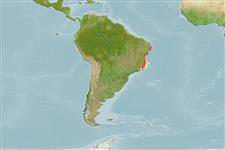Common names from other countries
>
Ovalentaria/misc (Various families in series Ovalentaria) >
Grammatidae (Basslets)
Etymology: Gramma: Greek, gramma, atos = signal, mark (Ref. 45335); brasiliensis: Named for the given distribution of this basslet; endemic to the Brazilian Province..
Environment: milieu / climate zone / depth range / distribution range
Écologie
marin récifal; profondeur 3 - 22 m (Ref. 27309). Tropical; 8°S - 23°S
Southwest Atlantic: endemic to Brazil.
Taille / Poids / Âge
Maturity: Lm ? range ? - ? cm
Max length : 6.6 cm SL mâle / non sexé; (Ref. 27309)
Found over coral and rocky bottoms, on the mainland coast and on coastal as well as oceanic islands. May be solitary or in groups of up to 4 individuals in small caves and under ledges, often swimming upside down, oriented to the ceiling. Feeds by picking at planktonic organisms in the water column; observed occasionally cleaning other fishes, including the pomacentrid Chromis multilineata and the haemulid Haemulon plumieri (Ref. 27309).
Life cycle and mating behavior
Maturité | Reproduction | Frai | Œufs | Fécondité | Larves
Sazima, I., J.L. Gasparini and R.L. Mourra, 1998. Gramma brasiliensis, a new basslet from the western South Atlantic (Perciformes: Grammatidae). aqua, J. Ichthyol. Aquat. Biol. 3(1):39-43. (Ref. 27309)
Statut dans la liste rouge de l'IUCN (Ref. 130435)
CITES (Ref. 128078)
Not Evaluated
Menace pour l'homme
Harmless
Utilisations par l'homme
Aquarium: Commercial
Plus d'informations
Noms communsSynonymesMétabolismePrédateursÉcotoxicologieReproductionMaturitéFraiFéconditéŒufsDéveloppement de l'œuf
Taille/Âge
Croissance
Longueur-poids
Longueur-longueur
Fréquences de longueurs
Morphométrie
Morphologie
Larves
Dynamique des populations larvaires
Recrutement
Abondance
RéférencesAquacultureProfil d'aquacultureSouchesGénétiqueElectrophoresesHéritabilitéPathologiesTraitementMass conversion
CollaborateursImagesStamps, Coins Misc.SonsCiguateraVitesseType de nageSurface branchialeOtolithesCerveauxVision
Outils
Articles particuliers
Télécharger en XML
Sources Internet
Estimates based on models
Preferred temperature (Ref.
115969): 24.7 - 27.3, mean 26.2 (based on 83 cells).
Phylogenetic diversity index (Ref.
82804): PD
50 = 0.5313 [Uniqueness, from 0.5 = low to 2.0 = high].
Bayesian length-weight: a=0.00389 (0.00180 - 0.00842), b=3.12 (2.94 - 3.30), in cm Total Length, based on all LWR estimates for this body shape (Ref.
93245).
Niveau trophique (Ref.
69278): 3.4 ±0.45 se; based on food items.
Fishing Vulnerability (Ref.
59153): Low vulnerability (10 of 100).
